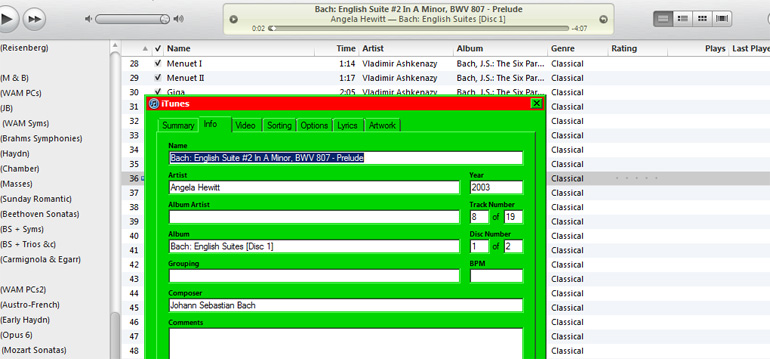Nano Note:
Bach in Order I-V
For nearly two months, on most weekdays (other than Friday), I’ve been cycling through five identical playlists, or versions of a template playlist, the difference between them being the performers. The original Bach in Order playlist is the first one below, headed by Trevor Pinnock’s recording of Arcangelo Corelli’s Concerti Grossi, Opus 6. Red type indicates that the performer plays on a harpsichord.
Each set begins and ends with a concerto grosso and includes the ordinal Bach suites. Thus, the first set comprises the English Suite No 1 in A, BWV 806; the French Suite No 1 in d, BWV 812; the Cello Suite No 1 in G, BWV 1007; and the Partita No 1 in B-Flat, BWV 825. It begins with the Concerto Grosso Op 6 No 1in D and ends with the Concerto Grosso Op 6 No 2 in F. The second set begins with the Concerto Grosso Op 6 No 3 in c, and includes the second English Suite, the second French Suite, the second Cello Suite, and the second Partita. And so on. There are six sets in all.
| Corelli Op 6 |
Pinnock | Ensemble 415 | Kuijken | Goodman | Marriner |
| English Suites |
Schiff | Kirkpatrick | Leonhardt | Hewitt | Levin |
| French Suites |
Jarrett | Rangell | Hewitt | Kirkpatrick | Gavrilov |
| Cello Suties |
Ma | Fournier | Harrell | Starker | Wispelwey |
| Partitas | Hewitt | Ashkenazy | Schiff | Gould | Perahia |
I don’t know when the first playlist was compiled; I believe that it dates back to 2009. Nor can I remember when it struck me that I ought to have more than one list, but once I had that idea, I settled on five in total. While there are many more recordings of the Cello Suites and the Partitas, and even a few more Corelli sets, complete recordings of the English and French Suites are relatively uncommon; most performers play the one or two that they like and are not encouraged, doubtless, to be exhaustive.
Round about the time I was compiling the four new playlists, I thought that it would be a good idea to insert other works by Bach between the pairs of concerti grossi that delimit the sets. The well-known Italian Concerto fits between the second and the third of the Concerti Grossi; the fourth and fifth are separated by the Chromatic Fantasy and Fugue, and so on. The last punctuating work, the Toccata in C, BWV 914, is the work that Thomas, the Romain Duris character, wants to play at his career-reviving audition, in Jacques Audiard’s De battre mon coeur s’est arreté; and the third version of the playlist includes the recording that Caroline Duris, the actor’s sister, made for the sound track.
| Italian Concerto | Perahia | Ross | Suzuki | Brendel | Kirkpatrick |
| Chromatic Fantasy & Fugue | Egarr | Brendel | Kirkpatrick | Ross | Hewitt |
| French Overture | Kirkpatrick | Hewitt | Gould | Suzuki | Ross |
| Goldberg Variations | Gould I | Tipo | Zhu | Nikolayevna | Schiff |
| Toccata BWV 914 | Von Asperen |
Egarr | Duris | Rübsam | Gould |
So far, I don’t know this music well enough to match up the different performances in a way that maximizes the interest of each, Fashions have changed a lot since Neville Marriner recorded the Corelli with the Academy of St Martin-in-the-Fields, and it shows, believe me. At some point, I’ll use one of Pablo Casals’s recordings of the Cello Suites, and I’m not sure that putting them next to Glenn Gould’s Partitas (arguendo) will be a good thing or a bad thing. We’ll see! The only programming criterion is to arrange things so that no performer appears on the same version “twice” — meaning that we don’t hear Gould playing the Toccata or the Goldberg Variations on the fourth version, the one with his Partitas; as it is, Angela Hewitt and Ralph Kirkpatrick are heard in every one. I’m beginning to feel the itch to rearrange things a bit, substituting one or two performances that I haven’t used so far. I have no intention of altering the template; that has worked very well. The Goldbergs, coming in the late afternoon, make for a complete change of pace, almost a hiatus — only one of the variations lasts as long as the sarabandes and courantes of the dance suites.
Since the beginning of March, only one or two weeks have gone by without my listening to any of these playlists; I usually manage three or four. If I’m going to be out for hours at a time, I find something else to listen to when I’m home; but once I’ve started a playlist, it plays through to the end. I’ve been getting better lately about starting the lists as soon as I get up. They run for about twelve hours, and it’s best to have them end before dinner — largely because Kathleen has become very tired of the antepenultimate item, the sixth Cello Suite. Which is a pity, because it’s my favorite.
I’ll be referring to these tables in future entries. I’ll be talking about how some of the hundreds of pieces (individual dances and variations) that comprise each list have emerged from the “wallpaper” of twelve hours of daily Bach; about how some of the different performers have become immediately recognizable (making it unnecessary for me to consult the table in order to know who’s playing what); and about what it’s like to wheel through the day alongside this musical planetarium.

